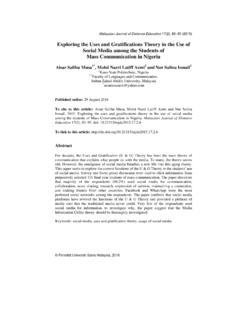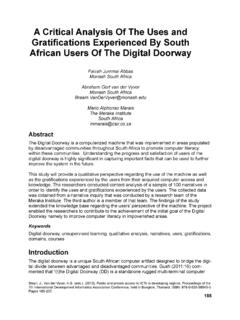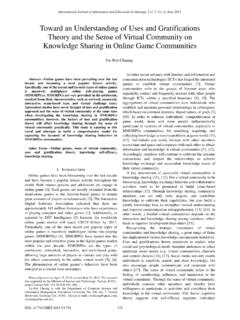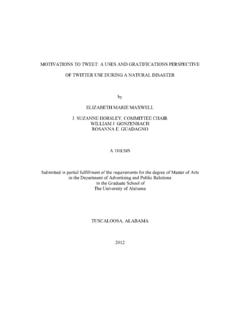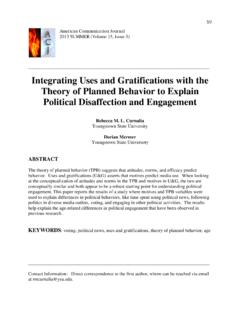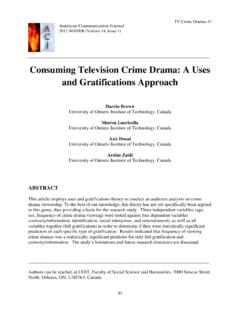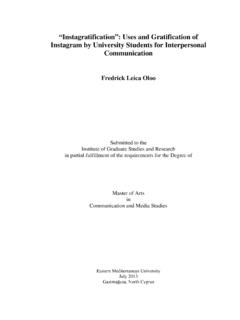Transcription of Uses and Gratifications of a Retired Female Athlete’s ...
1 485 International Journal of Sport Communication, 2010, 3, 485-500 2010 Human Kinetics, and Gratifications of a Retired Female Athlete s Twitter FollowersClavio is with the Dept. of Kinesiology, Indiana University, Bloomington, IN. Kian is with the College of Education, University of Central Florida, Orlando, ClavioIndiana University, USATed M. KianUniversity of Central Florida, USAAn Internet-based survey was posted on the Twitter feed of a Retired Female athlete to ascertain the demographics, uses , and Gratifications of her feed s followers. Analysis of the data revealed that followers were predominantly White, affluent, educated, and older than prior research into online audiences has shown.
2 The perception of the athlete as being an expert at her sport was the most salient reason reported to follow the Twitter feed, followed by affinity for the athlete s writing style. Analysis of variance uncovered 5 significant differences in item salience between male and Female followers, with women more likely to use this Twitter feed because of affinity for the athlete and men more likely to use it because of perception of the athlete as physically attractive. Factor analysis uncovered 3 dimensions of gratification: an organic fandom factor, a functional fandom factor, and an interactivity : Internet, socialization, new media, social networking, microbloggingThe social-networking phenomenon of Twitter has made considerable inroads into the sport communication landscape since its introduction in 2006.
3 One of the fastest growing Web applications in the new-media marketplace, Twitter com-bines several unique aspects of communication, which make it attractive to both sports fans and sport is an asynchronous form of social communication that has been com-pared to an online version of cell-phone text messaging (Angwin, 2009). Users gain access through free registration of an account, after which they can follow other users on the service to receive those users messages. In most cases, following is as simple as locating another user s Twitter name, then clicking a button. The user may then be followed by other users, and there is no requirement that a user being followed by another must reciprocate.
4 All users are limited to 140-character messages, although they may send as many messages as they want. Furthermore, users may use Web features such as link shorteners and picture galleries to share Web pages and multimedia with their Clavio and KianBased on its characteristics, Twitter is often referred to as a microblogging service (Java, Song, Finin, & Tseng, 2007). Microblogging can best be described as a derivative of blogging, which involves the transfer of news, personal opinion, and ideas in an online setting. Whereas blogging typically involves a dedicated Web site with a main-page focus on expansive content produced by an individual or small group, Twitter uses a much less media-rich interface, where the primary focus is on short bursts of content from a large number of that structure of many users, however, are smaller communities of users that coalesce around popular figures.
5 Whereas 74% of all Twitter users have fewer than 10 followers (Barracuda Laboratories, 2009), a very small percentage of users has a great many followers. Lardinois (2009) noted that of Twitter users have more than 2,000 followers, and although many of those with thousands of followers self-identify as Internet entrepreneurs (Lardinois, 2009), many of the accounts with multiple followers belong to celebrities including sports the feeds of sports figures, organizations, and media has become a popular pastime for many Twitter users. Coyle Media s ( ) Sports Fan Graph, which tracks the social-media followers of leagues and teams across multiple sports, illustrates this quite well. For instance, as of June 2010, the NBA had accrued over million followers on Twitter, with the NFL ( million), the Los Angeles Lakers ( million), and the Orlando Magic ( million) also reaching seven figures in Twitter followers.
6 Individual sport figures are also quite popular on Twit-ter, with athletes such as Lance Armstrong having million followers and many other athletes, coaches, and front-office members maintaining active feeds with numerous followers ( , ).The number of followers of sports figures and organizations on Twitter would seem to call for increased levels of scholarly inquiry into a whole range of topics including produced content, audience awareness, audience gratification, athlete gratification, and public relations impact. However, because of the nascence of Twitter as a legitimate communication and social-networking medium, the litera-ture is sparse, inside and outside of sport, that deals with Twitter and its impact on the communication landscape.
7 In fact, new media in sport communication is itself a relatively unstudied area. This is not surprising, because many scholars are not familiar enough with various forms of new media to feel comfortable analyzing the phenomena present in new-media sport communication methods (Dart, 2009). Regardless, steady progress has been made in this area, and several scholars have recently taken up the task of examining new media and their impact on the chang-ing sport communication landscape ( , Butler & Sagas, 2008; Clavio, 2008a, 2008b; Dart, 2009; Dittmore, Stoldt, & Greenwell, 2008; Kassing & Sanderson, 2010; Kian & Hardin, 2009; Plymire, 2008; Sanderson, 2008a, 2008b; Schultz & Sheffer, 2007, 2010). This study aims to add to that body of knowledge, both by building on the existing new-media sport communication literature and by scientifi-cally exploring new areas of inquiry in social of LiteratureWhereas there have been several scholarly inquiries into social networking and new media that focused on content and media producers, very few have examined new media from the perspective of audiences and content receivers.
8 This study will uses and Gratifications of Twitter 487focus on that hole in the literature by using the theoretical framework of uses and Gratifications . Furthermore, we examine the possible effects of a Retired Female athlete as the focus of content generated in a Twitter and GratificationsThis study aims to examine the Twitter phenomenon through the theoretical lens of uses and Gratifications theory (Katz, Blumler, & Gurevitch, 1974). This theory posits that media use is goal driven, with consumers of media using specific, selected channels to satisfy needs and achieve Gratifications . uses and Gratifications research relies on direct inquiry of media users regarding both their use of media and their reasons for it (Katz et al.)
9 , 1974). uses and Gratifications theory has been adopted by many communication researchers as a lens through which to examine audiences on the Internet because of the active nature of Internet audiences. Ruggiero (2000) noted that uses and Gratifications theory could be used to examine several content attributes not pres-ent in traditional media, including elements of interactivity, or level of control on the communication process, and asynchroneity, or the concept of messages being accessible at a time after they are sent. The very nature of Twitter is both interactive and asynchronous and would seem to fit well with the uses and grati-fications and Gratifications theory has been recently applied to Internet-based social networking, with scholars attempting to ascertain the nature of the participants and audiences therein.
10 Raacke and Bonds-Raacke (2008) used a uses and Gratifications approach to examine both participants and nonparticipants in the social networks MySpace and Facebook. A survey of college students revealed that the most salient uses for these social networks were to stay in touch with both old and current friends, to post or view pictures, and to make new acquaintances. Among other findings, the study discovered that Female users of social-networking sites were more likely than males to have their site information set to private. In a similar vein, Park, Kee, and Valenzuela (2009) employed uses and Gratifications to examine membership in Facebook groups as part of a study highlighting the predictive nature of online participation factors in civic involvement.
